

Re-visiting feminist art. Re-visiting feminist art In der Reihe Re-visiting feminist art setzt sich Cornelia Sollfrank mit frühen feministischen Arbeiten auseinander, in dem sie diese wiederholt.
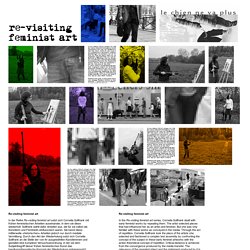
Sollfrank wählt dafür Arbeiten aus, die für sie selbst als Künstlerin und Feministin einflussreich waren. Sie kennt diese mittlerweile »historischen« Arbeiten jedoch nur durch mediale Vermittlung. Durch den Akt der Wiederholung setzt sich Cornelia Sollfrank an die Stelle der von ihr ausgewählten Künstlerinnen und gestaltet eine komplexe Versuchsanordnung, in der sie dem Subjektbegriff dieser frühen feministischen Kunst das handlungstheoretische Konzept der Wiederholung entgegensetzt. Aus der durch mediale Vermittlung entstandenen Nähe wird eine kritische Distanz. Testo yonqui. Beatriz Preciado (actualmente Paul B.

Preciado) | Testo yonqui El modelo capitalista actual se asienta en dos pilares fundamentales: la industria farmacéutica y la pornografía. En paralelo al discurso filosófico que analiza esta realidad farmacopornográfica, la autora relata un autoexperimento que le lleva a aplicarse testosterona, para desmentir con él la determinación biólógica del género y la sexualidad.
Best Fundraising Ideas - Whole World Best Fundraising Ideas. Feminist art. Feminist art is a category of art associated with late 1960's and 1970's feminist movement.
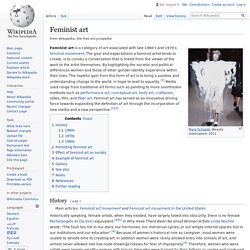
The goal and expectations a feminist artist tends to create, is to convey a conversation that is linked from the viewer of the work to the artist themselves. By highlighting the societal and political differences women and those of other gender identity experience within their lives. The hopeful gain from this form of art is to bring a positive and understanding change to the world, in hope to lead to equality. [1] Media used range from traditional art forms such as painting to more unorthodox methods such as performance art, conceptual art, body art, craftivism, video, film, and fiber art. Feminist art has served as an innovative driving force towards expanding the definition of art through the incorporation of new media and a new perspective.[2][3] History[edit] Feminist art can be contentious to define. 1960s[edit] 1970s[edit] Photography became a common medium used by feminist artists.
Lucy R. Mattress Performance (Carry That Weight) Karen Finley. Karen Finley (born 1956) is an American performance artist, musician and poet.
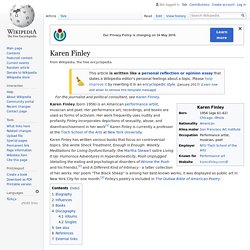
Her performance art, recordings, and books are used as forms of activism. Her work frequently uses nudity and profanity. Finley incorporates depictions of sexuality, abuse, and disenfranchisement in her work[1] Karen Finley is currently a professor at the Tisch School of the Arts at New York University. Biography[edit] Finley was born in Chicago and raised in Evanston, Illinois.
While Karen Finley was a student at the San Francisco Art Institute, she became immersed in the Bay Area's punk music scene, witnessing the emergence of the bands The Dils and the Dead Kennedys. In 1994, her album The Truth Is Hard to Swallow was re-released on CD, with a slightly different track listing, as Fear of Living.
In 2013, the New Museum in New York City presented Karen Finley's Sext Me If You Can, a highly personal performance that took place in the public lobby of the museum. Influences[edit] Books[edit] Museum of Modern Art. Karl Lagerfeld’s flimflam feminism won’t hurt the real thing. In 2006, Susan Faludi returned to the seminal feminist book that made her name, Backlash, and wrote a new prologue for the 15th anniversary: “In the years since feminism’s revival in the early 1970s, American women have sped across so much ground that we can scarcely recognise the lives our grandmothers lived … Yet as women near the finish line, we are distracted.
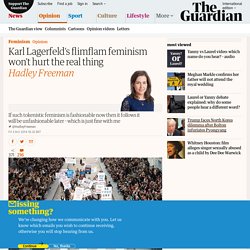
Maria Grazia Chiuri: ‘Dior deve occuparsi della legittimazione femminile’ Maria Grazia Chiuri ha assunto la carica di direttore artistico di Dior da poco più di un anno.
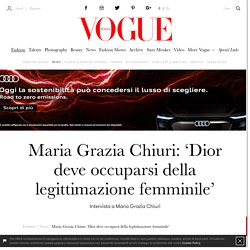
È un ruolo che non avrebbe mai immaginato di poter avere. “E perché?” Chiede. A Feminist Perspective on the Fast Fashion Industry. Are fashion and feminism compatible? Kathryn Flett, journalist and author of Separate Lives:
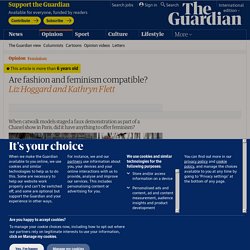
Fashion Brands Who Pass The Bechdel Test Of Feminism. This isn’t to say that brands cannot use International Women’s Day as an opportunity to truly do good.
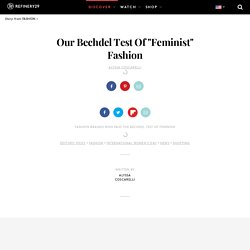
There are plenty of brands that pride themselves on gender parity and support women year-round — and in this case, IWD initiatives do actually advance their efforts and the cause in general. The history of feminist fashion - Vogue Australia. Everyone knows clothes can be powerful communication tools, but can they help change the world?
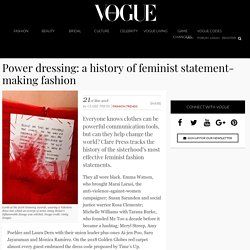
Clare Press tracks the history of the sisterhood’s most effective feminist fashion statements. They all wore black. Emma Watson, who brought Marai Larasi, the anti-violence-against-women campaigner; Susan Sarandon and social justice warrior Rosa Clemente; Michelle Williams with Tarana Burke, who founded Me Too a decade before it became a hashtag; Meryl Streep, Amy Poehler and Laura Dern with their union leader plus-ones Ai-jen Poo, Saru Jayaraman and Mónica Ramírez. On the 2018 Golden Globes red carpet almost every guest embraced the dress code proposed by Time’s Up. “This is a moment of solidarity, not a fashion moment,” Eva Longoria (a founding member of the campaign, who paired up with another, Reese Witherspoon, for the evening) told the New York Times.
Time’s Up challenges the culture of workplace sexual assault, harassment and discrimination everywhere. Priyanka Paul (@artwhoring) Laura Callaghan (@lauracallaghanillustration) Maria Grazia Chiuri: ‘Dior deve occuparsi della legittimazione femminile’ Il nuovo femminismo sceglie la moda per comunicare. Maria Grazia Chiuri: ‘Dior deve occuparsi della legittimazione femminile’ Remera Girl Power - Comprar en UNITIVO.